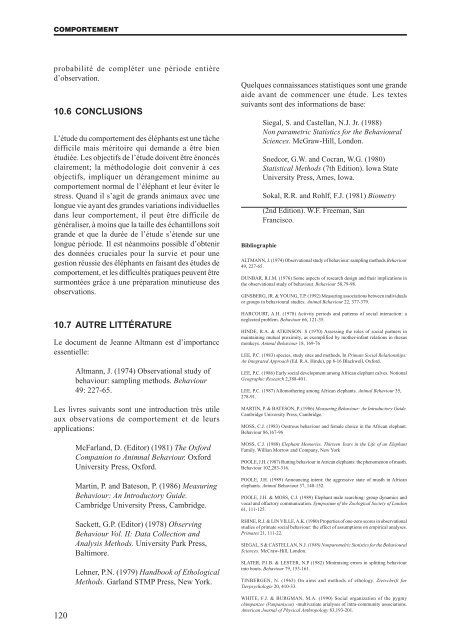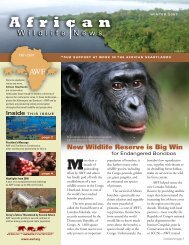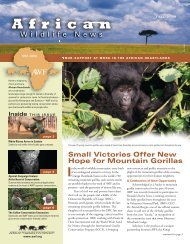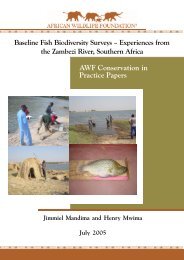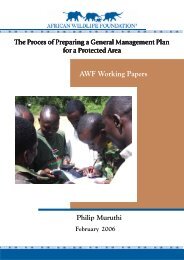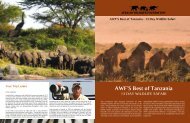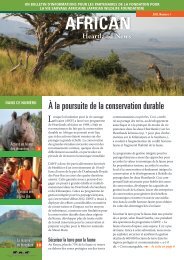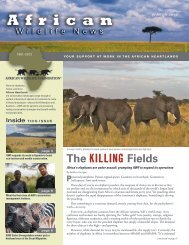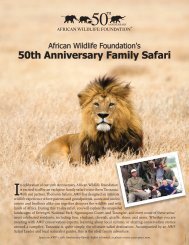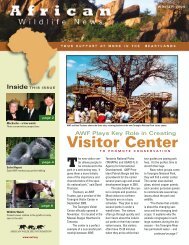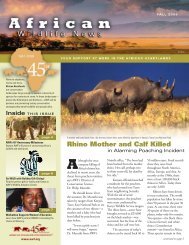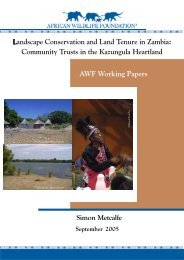1er CHAPITRE - African Wildlife Foundation
1er CHAPITRE - African Wildlife Foundation
1er CHAPITRE - African Wildlife Foundation
You also want an ePaper? Increase the reach of your titles
YUMPU automatically turns print PDFs into web optimized ePapers that Google loves.
COMPORTEMENT<br />
probabilité de compléter une période entière<br />
d’observation.<br />
10.6 CONCLUSIONS<br />
L’étude du comportement des éléphants est une tâche<br />
difficile mais méritoire qui demande a être bien<br />
étudiée. Les objectifs de l’étude doivent être énoncés<br />
clairement; la méthodologie doit convenir à ces<br />
objectifs, impliquer un dérangement minime au<br />
comportement normal de l’éléphant et leur éviter le<br />
stress. Quand il s’agit de grands animaux avec une<br />
longue vie ayant des grandes variations individuelles<br />
dans leur comportement, il peut être difficile de<br />
généraliser, à moins que la taille des échantillons soit<br />
grande et que la durée de l’étude s’étende sur une<br />
longue période. Il est néanmoins possible d’obtenir<br />
des données cruciales pour la survie et pour une<br />
gestion réussie des éléphants en faisant des études de<br />
comportement, et les difficultés pratiques peuvent être<br />
surmontées grâce à une préparation minutieuse des<br />
observations.<br />
10.7 AUTRE LITTÉRATURE<br />
Le document de Jeanne Altmann est d’importancc<br />
essentielle:<br />
120<br />
Altmann, J. (1974) Observational study of<br />
behaviour: sampling methods. Behaviour<br />
49: 227-65.<br />
Les livres suivants sont une introduction très utile<br />
aux observations de comportement et de leurs<br />
applications:<br />
McFarland, D. (Editor) (1981) The Oxford<br />
Companion to Animnal Behaviour. Oxford<br />
University Press, Oxford.<br />
Martin, P. and Bateson, P. (1986) Measuring<br />
Behaviour: An Introductory Guide.<br />
Cambridge University Press, Cambridge.<br />
Sackett, G.P. (Editor) (1978) Observing<br />
Behaviour Vol. II: Data Collection and<br />
Analysis Methods. University Park Press,<br />
Baltimore.<br />
Lehner, P.N. (1979) Handbook of Ethological<br />
Methods. Garland STMP Press, New York.<br />
Quelques connaissances statistiques sont une grande<br />
aide avant de commencer une étude. Les textes<br />
suivants sont des informations de base:<br />
Bibliographie<br />
Siegal, S. and Castellan, N.J. Jr. (1988)<br />
Non parametric Statistics for the Behavioural<br />
Sciences. McGraw-Hill, London.<br />
Snedcor, G.W. and Cocran, W.G. (1980)<br />
Statistical Methods (7th Edition). Iowa State<br />
University Press, Ames, Iowa.<br />
Sokal, R.R. and Rohlf, F.J. (1981) Biometry<br />
(2nd Edition). W.F. Freeman, San<br />
Francisco.<br />
ALTMANN, J. (1974) Observational study of behaviour: sampling methods.Behaviour<br />
49, 227-65.<br />
DUNBAR, R.I.M. (1976) Some aspects of research design and their implications in<br />
the observational study of behaviour. Behaviour 58,79-98.<br />
GINSBERG, JR. & YOUNG, T.P. (1992) Measuring associations between individuals<br />
or groups in behavioural studies. Animal Behaviour 22, 377-379.<br />
HARCOURT, A.H. (1978) Activity periods and pattems of social interaction: a<br />
neglected problem. Behaviour 66, 121-35.<br />
HINDE, R.A. & ATKINSON. S (1970) Assessing the roles of social partners in<br />
maintaining mutual proximity, as exemplified by mother-infant relations in rhesus<br />
monkeys. Animal Behaviour 18, 169-76<br />
LEE, P.C. (1983) species, study sites and methods, In Primate Social Relationships:<br />
An Integrated Approach (Ed. R.A. Hinde), pp 8-16 Blackwell, Oxford.<br />
LEE, P.C. (1986) Early social development among <strong>African</strong> elephant calves. Notional<br />
Geographic Research 2,388-401.<br />
LEE, P.C. (1987) Allomothering among <strong>African</strong> elephants. Animal Behaviour 35,<br />
278-91.<br />
MARTIN, P. & BATESON, P. (1986) Measuring Behaviour: An Introductory Guide.<br />
Cambridge University Press, Cambridge.<br />
MOSS, C.J. (1983) Oestrous behaviour and female choice in the <strong>African</strong> elephant.<br />
Behaviour 86,167-96<br />
MOSS, C.J. (1988) Elephant Memories. Thirteen Years in the Life of an Elephant<br />
Family. Willian Morrow and Company, New York<br />
POOLE, J.H. (1987) Rutting behaviour in Atrican elephants: the phenomenon of musth.<br />
Behaviour 102,283-316.<br />
POOLE, J.H. (1989) Announcing intent: the aggressive state of musth in <strong>African</strong><br />
elephants. Animal Behaviour 37, 140-152.<br />
POOLE, J.H. & MOSS, C.J. (1989) Elephant male searching: group dynamics and<br />
vocal and olfactory communication. Symposium of the Zoological Society of London<br />
61, 111-125.<br />
RHINE, R.J. & LIN VILLE, A.K. (1980) Properties of one-zero scores in observational<br />
studies of primate social behaviour: the effect of assumptions on empirical analyses.<br />
Primates 21, 111-22.<br />
SIEGAL, S & CASTELLAN, N.J. (1988) Nonparomelric Stotistics for the Behavioural<br />
Sciences. McCraw-Hill, London.<br />
SLATER, P.J.B. & LESTER, N.P (1982) Minimising errors in splitting behaviour<br />
into bouts. Behaviour 79, 153-161.<br />
TINBERGEN, N. (1963) On aims and methods of ethology. Zietschrift fur<br />
Tierpsychologie 20, 410-33.<br />
WHITE, F.J. & BURGMAN, M.A. (1990) Social organization of the pygmy<br />
chimpanzee (Panpaniscus) -multivariate arialyses of intra-community associations.<br />
American Journal of Physical Anthropology 83,193-201.


